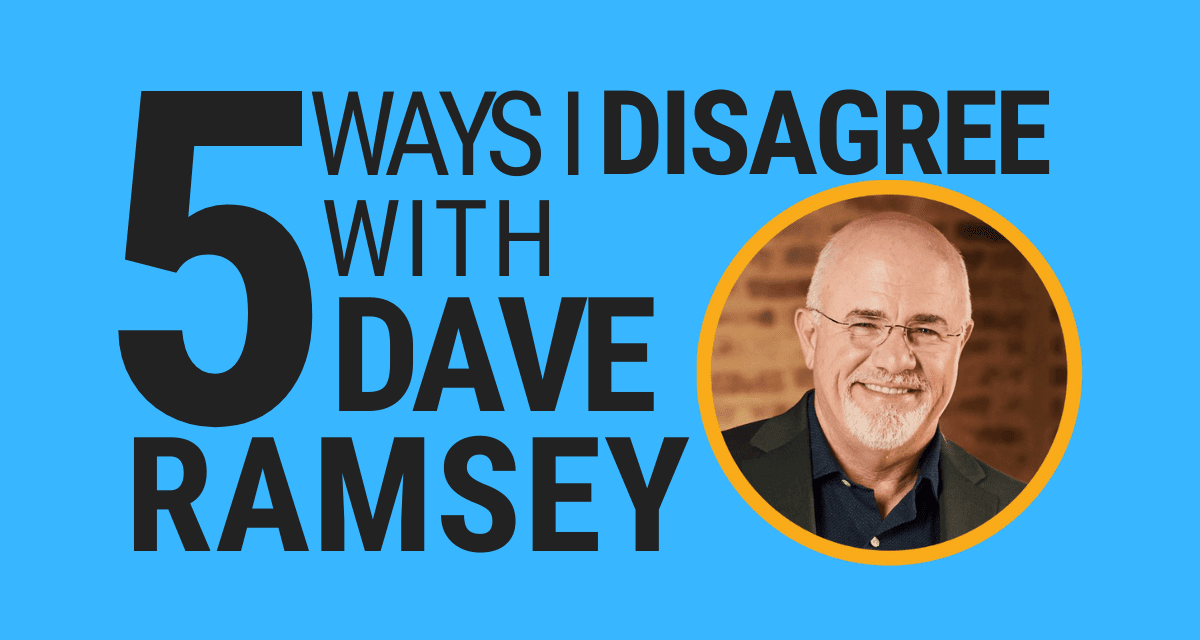Dave Ramsey is a personal finance guru with many years of wisdom. He’s helped thousands get out of debt and achieve financial freedom. Regardless, Dave Ramsey has views that I consider should be updated.
Let’s dive into 5 of my differing views with Dave Ramsey.
Use the ‘Debt Snowball’ Method to Get Out of Debt
Dave Ramsey is adamant that everyone should use the snowball method to get out of debt. Dave’s main point is that paying off the smallest debts first is a motivational issue, saying that “it’s important to pay your debts in a way that keeps you motivated until you’ve wiped them out.”
And yes, there is a definite psychological benefit to seeing your debts eliminated one-by-one. Kellogg School of Management conducted a study in 2012 that found that “people with large credit-card balances are more likely to pay down their entire debt if they focus first on paying off the cards with the smallest balances — even if that approach doesn’t make the best economic sense.”
So why don’t I agree? The reason is simple. Not everyone is the same when it comes to “gazelle intensity,” and for those that are wired up differently, the snowball method can cost them thousands more in interest over time.
What is ‘Gazelle Intensity?’
Everyone has different motivations to get out of debt. There are many people who are ‘gazelle intense,’ and they will do anything to eliminate debt. These people don’t necessarily need the psychological benefit of seeing smaller debts eliminated. They would get out of debt regardless.
Snowball Interest
More importantly, you can lose thousands of dollars in interest by following the snowball method. For example, we were working with one individual who owed $13,000 at 2%, $40,000 at 12% and $22,000 at 3%. Following snowball could have cost him approximately $12,000 in interest payments versus the ‘Avalanche Method.’
However, it’s not all or nothing. You can look to do a combination of snowball and avalanche. There are specific applications, such as Savvy Debt Payoff App, that take into consideration both methods and help you determine which method is right for you.
There is No Such Thing as Good Debt
There are many debts that I believe are good debts. Unfortunately, Dave and I would disagree here.
When you borrow money at a low fixed rate, and use the proceeds to buy a high return investment, you should consider the difference between the investment’s rate of return and the interest rate. (To dive deeper into this, take a look at the SMN article, “Good Debt vs Bad Debt.”) In college, I took a loan that had a 0% deferred interest rate and invested that money into a CD yielding 5%. (This was a different time, before near-zero interest rates were the norm.) I made a lot of money on the interest while in school and then paid off the loan right after college.
I consider that ‘good debt.’
Secondly, medical school costs a great deal and can rarely be done without debt. I consider this a good debt because you are furthering your career. However, I do not consider all college debt good, because there are some college degrees that do not provide enough economic value to the individual to even payoff the student debt, much less raise your standard of living.
Save $1,000 for Your Starter Emergency Fund
Dave Ramsey created the Baby Steps in the early 1990’s. A $1000 emergency fund would go a lot further in 1990 than 2020. Today, a $1000 emergency fund may not go very far to help you get out of an emergency.
Alternatively, you could consider taking a percentage of your income or your expenses. Each situation is different, and $1000 is an overly simplistic number. You don’t need a prescriptive amount.
Pay Off Your Home Early
Paying off your home early is a very good thing to do, but this is again where Dave Ramsey is prescriptive in his approach rather than providing guidance that allows flexibility. For example, let’s say you have a 30-year fixed mortgage loan at 3.5% and you’re also able to take a tax deduction on the interest. In this case, the after-tax interest rate might be around 2.5%, and that’s locked in for 30 years. Assuming you can find an investment opportunity that yields more than 2.5%, it might make sense to put money in that instead.
You Can Make 12% Per Year
Dave Ramsey has received some press on his aggressive investment return assumptions. He often claims that investors should expect to make 12% on their money. His team even wrote an article covering the 12% reality where he takes the current average S&P annual return from 1923 to 2016, which results in 12.25%.
Robert Berger, a contributor for US New & World Report, wrote a very detailed article titled, “Why You Won’t Achieve 12 Percent Returns,” and he gives four reasons to doubt the 12% return:
- The calculation is misleading. He uses an average return, and an average return does not account for volatility. As volatility increases, the gap between average and annual returns increases.
- Dave Ramsey uses this 12% number to justify an 8% withdrawal in retirement. Unfortunately you may run out if you withdraw so much.
- You may take on too much risk because you are expecting a 12% return. This may be harmful if a high risk investment goes sour.
- Robert argues that chasing a 12% return may result in a portfolio that is exposed to high investment fees. You should consider the fee of the fund before pursuing it.
(If you want to know what is realistic to expect in the stock market, check out this SMN article with all the details you should know.)
Conclusion
Dave Ramsey has been an asset to friends and family alike. He has also helped me shape some of my own views of personal finance. However, I believe that he should consider updating his views, because some of his views range from too prescriptive and outdated to potentially harmful to the individual.



